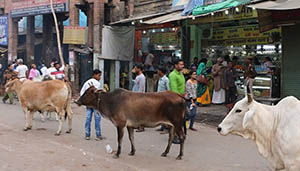National Milk Day: From Red Cherry Cheeks to a Dairy Dilemma in Himachal...
Shimla/New Delhi: Remember the good old days when a half-glass of Pahadi cow milk, a bowl of thick dahi, and a spoonful of ghee gave us rosy, red cheeks?
Today, kids drink full glasses of Jersey cow milk, but the cherry glow is gone.
The shift is stark. The White Revolution gave us milk in abundance, but Himachal's dairy story needs a revival, steeped in its rich traditions.
India, the world’s largest milk producer, churns out 230.58 million tonnes annually. That’s 25% of global production. Yet, concerns over milk quality and rampant adulteration persist, dampening the celebration.
The Rise and Fall of Pahadi Cows
In Himachal Pradesh, Pahadi cows were once the pride of every household. Their milk was rich, nutritious, and full of goodness.
But they’ve been replaced by Jersey and Holstein breeds. These exotic cows produce more milk but lack the wholesome nutrients of Pahadi milk.
Local milk producers like Milkfed and Kamdhenu struggle to compete with giants like Punjab’s Verka. The traditional milk ecosystem is falling apart. To add to the chaos, stray cattle have become a menace. Unproductive cows are abandoned, crowding roads, causing accidents, and raising welfare concerns. Gaushalas are trying but failing to solve the problem.
Milk Sector Gets a Boost, but Challenges Remain
Himachal produces 15.44 lakh metric tonnes of milk annually, boosting rural incomes. The state even set an MSP for milk this year. Cow milk now fetches ₹45/liter, and buffalo milk ₹55/liter.

Under the Him Ganga Yojana, with a ₹500 crore budget, a modern plant in Kangra will process 3 lakh liters daily. Products like ghee and cheese will soon hit the market. Expansion plans are in place for plants in Kullu, Hamirpur, Nahan, and Una, with 47,000 farmers benefiting.
The government has also earmarked ₹150 crore for procurement infrastructure, including bulk coolers, collection units, and refrigerated vans. Farmers are optimistic but impatient. Promises need swift execution.
India’s White Revolution: A Milky Legacy
Dr. Verghese Kurien’s Operation Flood transformed India into a dairy giant. In three phases, from 1970 to 1996, milk-sheds expanded, cooperatives thrived, and self-sufficiency was achieved.
Today, milk is worth a whopping ₹11.16 lakh crore annually, supporting 8.5 crore rural households across India.
Himachal’s Unique Challenges
Himachal’s dairy sector has its battles. Despite being the first state to set MSPs, its milk production can’t match rising demands. The per capita milk availability in India is 459 grams/day, but Himachal struggles to meet this.
Indigenous breeds are fading away. Initiatives like the Rashtriya Gokul Mission and National Programme for Dairy Development aim to help, but progress is slow. Universities have failed to promote Pahadi cows, further widening the gap.
Empowering Women in Dairy
Women are the backbone of India’s livestock workforce, comprising 69% of the sector. In Himachal, they play a vital role in dairy farming. Empowering them through cooperatives could revolutionize rural livelihoods. Models like the Mulukanoor Women’s Dairy Cooperative in Andhra Pradesh show what’s possible.
A Call for a New White Revolution
National Milk Day is a time to honor Dr. Kurien’s vision. But it’s also a moment for introspection. Himachal must revive Pahadi cows, tackle stray cattle issues, and improve milk quality.
The state needs a dairy revolution that’s not just white, but deeply rooted in its Himalayan heritage. Only then can we bring back the red cheeks and the pride of our Pahadi cows.
It is challenge to our dairy sector, animal husbandry department and to the research and development wings of our state universities.







